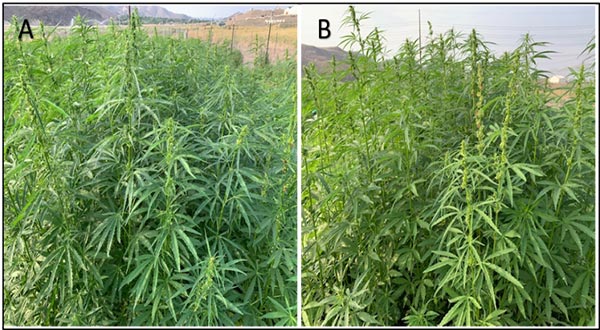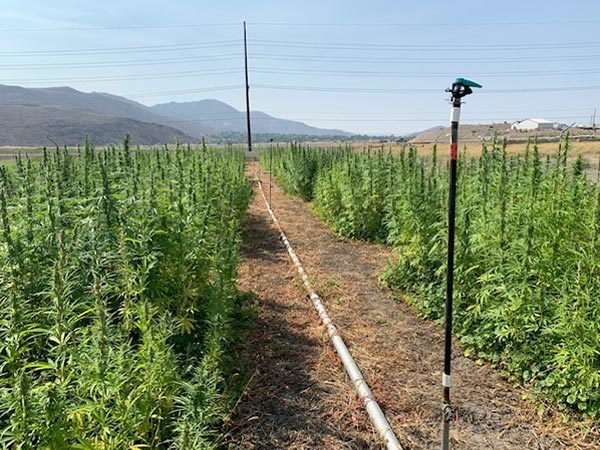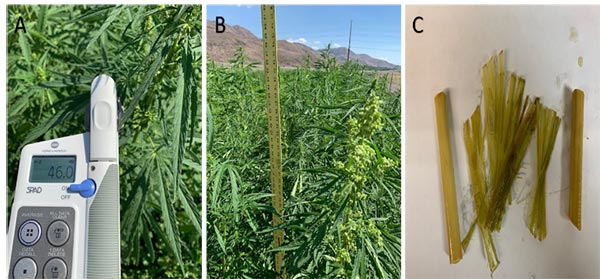Over the past eight years, there has been a renewed interest in the commercial cultivation and end products [e.g., cannabidiol (CBD) oil, grain and fiber] utilization of industrial hemp (Cannabis sativa L.). Legal cultivation of hemp was authorized with the passage of the 2014 United States Farm Bill (U.S. Government Printing Office, 2014). This bill defined hemp as cannabis and derivatives of cannabis with extremely low concentrations of the psychoactive compound delta-9-tetrahydrocannabinol (THC) with no more than 0.3% total THC (delta-9 THC + 0.877*THCA) on a dry-weight basis (U.S. Government Printing Office, 2014). With its removal from the Controlled Substances Act, the 2018 United States Farm Bill allowed hemp to be regulated like traditional crops. While widespread legal cultivation is now possible, there are, however, multiple regulations that must be followed to comply with state and federal guidelines. In Nevada, guidance for industrial hemp must be sought from the Nevada Department of Agriculture (e.g., hemp grower certificate, pre-harvest hemp testing for THC content).
At this early stage, growers' interest is primarily focused on the production of high CBD hemp types. However, there is now a growing interest in the cultivation of hemp as a source of natural fiber and its diverse applications in the production of innovative biomaterials (e.g., Vandepitte et al., 2020; Tang et al., 2022). The use of fiber hemp is not new in the production of environmentally friendly natural fibers (bast and hurd) for composite materials (Shahzad, 2011). Bast fiber is the long and string-like fibers in the bark of hemp stalks. The bast fiber is used for fabric, insulation, carpeting, paneling, batteries, cordage, pulp recycling, bagging and fiberboard, among other applications. On the other hand, the hurd (tow) are short fibers located in the stem core and are used for fiberboard, mortar, paper filler, absorbent, animal bedding, mulch, plastic, paints, hempcrete and sealants, among other applications (Shahzad, 2011; Gabrion et al., 2022). Hemp’s wide adaptation, fast-growing characteristics as an annual crop, low water use, and modest demand for fertilizer (Tsaliki et al., 2021; Gabrion et al., 2022), make it an ideal bio-economy crop suitable for integration into the annual crop production cycle in Nevada’s semiarid environment.
For hemp to be fully integrated into Nevada’s crop production system, multiple agronomic questions need answers at the field scale for sustainable production of the crop. Fundamental agronomic information must start with an understanding of varietal (genotype) response (e.g., fiber biomass production) to Nevada's semiarid growing conditions. This information will serve as a critical tool to guide interested growers in sourcing the right fiber hemp genetics to optimize and sustain fiber production in Nevada’s environment. Our small-scale fiber hemp varietal evaluation is aimed at providing interested growers with initial foundational knowledge as a basis for agronomic best management practices based on biomass and fiber yield performance. The objective of this study was to determine biomass and bast fiber yield of two dual-purpose fiber hemp varieties grown under irrigation.
Materials and methods
Study site
This fiber hemp varietal evaluation was carried out in Reno, Nevada, during the summer of 2021 at the Main Station Field Laboratory of University of Nevada, Reno. The soil is a Voltaire loam (a Fine-loamy, mixed, superactive, calcareous, mesic Fluvaquentic Endoaquolls). Before seeding, soil samples were randomly collected across the experimental area to a depth of 15 cm (6.0 inches), composited and sent to a commercial laboratory for analysis (A & L Western Agricultural Laboratories, Modesto, California). The mean soil pH was 7.0, with organic matter of 3.4%, CEC of 16.3 meq/100 g, and NO3-N, Olsen extractable P, K, Mg, Ca, Na, and S were 24, 32, 312, 507, 2155, 227 and 14 mg kg-1, respectively. Total precipitation during the growing season (June – October) was minimal (0.81 inch).
Experimental design
Two fiber hemp varieties (Altair and Hliana) were arranged in a randomized complete block design experiment with eight replications each.
Brief description of varieties
The variety Altair is a dual-purpose grain and fiber type. It is monoecious, has very good lodging resistance, matures by 105 days, has moderate branching, and is highly uniform in flowering and plant height of 56 – 64 inches. Hliana is also a monecious dual-purpose variety (grain and fiber). It has a vegetation period of 115-120 days and a typical plant height range of 96 – 132 inches (Figure 1).

Figure 1. Fiber hemp varieties (A) Altair and (B) Hliana were used in this 2021 varietal evaluation.
Crop establishment and management
Before seeding, glyphosate [active ingredient (a.i.), N-(phosphonomethyl) glycine] was used at an application rate of 1 pound a.i./acre for weed control in the experimental area. The experimental area was plowed, disked and leveled before seeding. Each plot measured 20 feet long by 5 feet wide. Alleyways between plots and blocks were 10 feet wide (Figure 2). The plots were seeded at a rate of 25 pounds pure live seed/acre for each variety on June 18, 2021, using a Wintersteiger Plotseed XL seeder in eight rows spaced 8 inches apart.
Supplemental irrigation was applied through a solid-set sprinkler system for a total of 1 inch of water weekly. Phosphorous based on soil test recommendations was applied uniformly to each plot at a rate of 40 pounds P2O5/acre using triple superphosphate (0-45-0) shortly after sowing. Nitrogen was also applied uniformly at a rate of 80 pounds N/acre using urea (46-0-0) shortly after sowing.

Figure 2. Fiber hemp plot layout at Main Station Field Laboratory, Reno, Nevada, 2021.
Data collection Both SPAD value (SPAD 502 Plus Chlorophyll Meter, Minolta, Spectrum Technologies Inc., Aurora, Illinois, USA) and leaf area index (LAI-2200C Plant Canopy Analyzer, LI-COR Biosciences Inc. Lincoln, Nebraska, USA) were measured three weeks after germination and weekly thereafter, until the end of September 2021 to estimate the seasonal averages of each fiber hemp variety. The SPAD value is a measurement of leaf greenness, which provides an estimate of the amount of leaf chlorophyll concentrations and helps us understand the nutritional condition of the plant, crop nitrogen utilization and potential yield of the crop. It also helps us to establish a threshold value for the nitrogen application rate for the crop (e.g., Xiong et al., 2015). The LAI 2200C Plant Canopy Analyzer uses a non-destructive method to easily and accurately measure Leaf Area Index (LAI). Plant height from the soil surface to the tip of the panicle (apical point) was measured at the time of harvest (Oct. 10, 2021; 114 days after sowing) from three randomly selected plants in each plot. Plant stem diameter was determined using a caliper from three stems in each replicate plot by measuring the upper, middle and lower sections of the stem to determine the average diameter of each stem. Before harvesting, hemp varieties were sampled (flower and plant material) by Nevada Department of Agriculture personnel to determine the delta-9-tetrahydrocannabinol (THC) content. Hemp was harvested by clipping with a hand shear to a reference stubble height of 2 inches above the ground at the end of the growing season (Oct. 10, 2021; 114 days after sowing) from an area of 16 ft.2 to quantify biomass (stem, bast fiber and shive yield). Total fresh stem biomass of both varieties was determined from each plot. The top part of the hemp plant containing the panicle and leaves was removed to keep the stem only. Thereafter, the hemp stalk was weighed (fresh), and a subsample of 0.5 kg was collected for water retting (5 days) to remove the fiber (Figure 3). Bast fiber and shive (stem core) were then oven-dried separately to determine their content. The bast fiber and stem core (shive) biomass were calculated for each replicate by multiplying the total biomass by the percent of fiber or shive.

Figure 3. (A) Fiber hemp SPAD measurement, (B) plant height and (C) bast fiber removal through water retting.
Statistical analysis
The data were analyzed using the GLIMMIX procedure of SAS version 9.4 (SAS Institute, 2015). Variety was the fixed effect, while replication (block) was treated as the random effect. Variety means were compared using the PDIFF option of the LSMEANS procedure in SAS and considered different at P ≤ 0.05 unless otherwise stated.
Results and discussion
The delta-9-tetrahydrocannabinol (THC) content of Altair (0.02%; Test #: 20210930AB02) and Hliana (0.01%; Test #: 20210930AB03) was well below the legal limit and thus met the criterion description of hemp.
Fiber hemp plant canopy traits (SPAD value, leaf area index; LAI and plant height) In this study, the mean seasonal SPAD values did not differ between the two varieties of fiber hemp (Table 1). Throughout the growing season, the seasonal mean SPAD value was 44.7 for these fiber hemp varieties fertilized at 80 lb N/acre (Table 1). In this study, the seasonal average leaf area index was greater (P = 0.043) for the variety Altair compared to Hliana (Table 1). At harvest, plant height was not different between the two varieties (Table 1). The mean plant height of the two hemp varieties was 64 inches (Table 1). In contrast to our study, Burgel et al. (2020) observed that the mean SPAD value was influenced by the genotype of two CBD hemp varieties grown under greenhouse conditions. The results from our study suggest that the two varieties had similar uptake and partitioning of N (N nutrition), carbon assimilation capacity, and resource-use efficiency when grown in Nevada’s semiarid environment. The leaf area index is a key biophysical metric used to characterize the growth of plants, and it is an index of the photosynthetic capacity of the plant by radiation interception that ultimately determines biomass production (Breda, 2008). The difference in LAI between the two varieties is not uncommon, as several factors apart from genetics can account for this variability. There were some noted differences in the plant population (because of poor germination) of some plots, which may account for the differences in LAI in this study. The LAI in this study for the two varieties was within (Altair) and marginally below (Hliana) the range of 1.15 to 2.29 m2 m-2 reported for hemp (Tang et al., 2018). Plant height is strongly correlated with biomass and fiber (bast and hurd) production of hemp. Similar to our study, in Vermont, USA, Darby et al. (2020) reported no statistical difference in plant height between the dual-purpose fiber hemp varieties Altair (43 inches) and Hliana (42 inches). The range of plant height among the nine fiber hemp varieties evaluated by Darby et al. (2020) in Vermont, was 34 to 49 inches. Unlike our study, fiber hemp plant height differed among varieties in eight contrasting environments in southern Italy (37.4 to 91.3 inches; Cosentino et al., 2013) and in northern Greece (52 to 67 inches; Tsaliki et al., 2021). The mean plant height in our study was within the range reported in these studies. The reported taller varieties are dioecious compared to the monoecious varieties used in our study, which are generally shorter (Cosentino et al., 2013).
Fiber hemp stem diameter
At harvest, the two varieties of fiber hemp did not differ in their stem diameter (Table 1). The mean stem diameter for the two varieties was 7.8 mm (Table 1). Stem diameter can limit the total fiber production from fiber hemp (Tang et al., 2017). Similar to our study, stem diameter was not different among the nine dual-purpose (fiber and grain) hemp varieties evaluated in Kansas (5.6 to 13.9 mm; Griffin et al., 2019) or Kentucky in the United States (4.5 mm to 8.44 mm; Williams et al., 2019). The two varieties evaluated in this study also had similar stem diameter to those (6.0 to 9.4 mm) reported by Tang et al. (2017). Percent hemp bast fiber and shive (stem core)
The percent bast fiber was not influenced by variety in this evaluation (Table 1). For the two varieties, the mean bast fiber was 32.3% (Table 1). Similar to the trend in percent bast fiber, the percent shive (stem core) did not differ between the two varieties (Table 1). The mean percent shive for the two fiber hemp varieties was 67.8 (Table 1). The mean percent bast fiber in this study was greater than the range of 24.41 to 26.02% reported in a study in northern Greece (Tsaliki et al., 2021). In Vermont, USA, Darby et al. (2020) reported no statistical differences in percent bast fiber between Altair (22.8% ± 5.76) and Hliana (25.8% ± 5.76). Darby et al. (2020) reported a range of 22.8 to 30.7% bast fiber among the hemp varieties evaluated, and this range was below the mean bast fiber percent in this study.
Fiber hemp biomass, bast fiber and shive yield
Between the two fiber hemp varieties, biomass, bast fiber and stem yield were not different (Table 1). At harvest, the mean biomass, bast fiber and stem yield were 3783 pounds/acre, 1192 pounds/acre and 2990 pounds/acre, respectively (Table 1). Stem yield in this study was greater than the range reported for dual-purpose hemp in Kansas (347 to 1089 pounds/acre; Griffin et al., 2019) and different locations in Kentucky (890.1 to 2791.7 pounds/acre; Williams et al., 2018). Unlike this study, the variety Altair (8558 pounds/acre) produced a substantially greater biomass yield than Hliana (4306 pounds/acre) in Vermont, USA (Darby et al., 2020). The similar biomass, bast fiber and shive yield in this study are not unexpected, as these two varieties displayed similar plant canopy traits apart from LAI.
Summary
Overall, based on production parameters of fiber hemp grown in other environments compared to this study, there is a clear indication of the suitability of this environment in Nevada for fiber hemp production. This study only evaluated two fiber hemp varieties that are classified as dual-purpose (fiber and grain), but the data gathered provide a baseline understanding of the differential responses to the measured traits that will be crucial for the overall management of fiber hemp at the field scale in Nevada. The overall lack of differences in the production parameters between the two varieties may be an indication of their genotypic closeness. The adoption of fiber hemp as a potential crop for Nevada will be dictated by its profitability. Therefore, potential producers must consider the risks associated with the hemp industry when deciding on its integration into existing cropping systems. In Nevada, large-scale trials with more varieties, multiple locations, testing of different agronomic management practices, and economic assessments are warranted to support fiber hemp adoption.
For the complete fact sheet with tables and charts include, contact the authors below for the PDF version.
Funding: This study was supported by the American Hemp Corporation, LLC grant #01-00003103.
References
- Breda, N. J. J. (2008). Leaf area index. In: Jorgensen, S.E., Fath, B.D. (Eds.), Encyclopedia of ecology. Elsevier B.V., Amsterdam, pp. 2148–2154.
- Burgel, L., Hartung, J., & Graeff-Hönninger, S. (2020). Impact of different growing substrates on growth, yield and cannabinoid content of two Cannabis sativa L. genotypes in a pot culture. Horticulturae, 6(4), 62.
- Cosentino, S. L., Riggi, E., Testa, G., Scordia, D., & Copani, V. (2013). Evaluation of European developed fibre hemp genotypes (Cannabis sativa L.) in semi-arid Mediterranean environment. Industrial Crops and Products, 50, 312–324.
- Darby, H., Bruce, J., Luke, I., & Malone, R. (2020). 2020 Industrial hemp fiber variety trial. Retrieved April 11, 2022,
- Gabrion, X., Koolen, G., Grégoire, M., Musio, S., Bar, M., Botturi, D., Rondi, G., de Luycker, E., Amaducci, S., Ouagne, P., Van Vuure, A., & Placet, V. (2022). Influence of industrial processing parameters on the effective properties of long aligned European hemp fibres in composite materials. Composites Part A: Applied Science and Manufacturing, 157, 106915. https://doi.org/10.1016/j.compositesa.2022.106915
- Griffin, J., Roozeboom, K., Haag, L., Shelton, M., Wilson, C., & Myers, T. (2019). 2019 K-state industrial hemp dual-purpose & fiber trial. Retrieved April 11, 2022, from https://www.northwest.k-state.edu/agronomy/documents/industrial_hemp/PairCenter2019IndustrialHempReport.pdf
- Shahzad, A. (2011). Hemp fiber and its composites – A Review. Journal of Composite Materials, 46(8), 973–986.
- Tang, K., Fracasso, A., Struik, P. C., Yin, X., & Amaducci, S. (2018). Water- and nitrogen-use efficiencies of hemp (Cannabis sativa L.) based on whole-canopy measurements and modeling. Frontiers in Plant Science, 9.
- Tang, K., Struik, P. C., Yin, X., Calzolari, D., Musio, S., Thouminot, C., Bjelková, M., Stramkale, V., Magagnini, G., & Amaducci, S. (2017). A comprehensive study of planting density and nitrogen fertilization effect on dual-purpose hemp (Cannabis sativa L.) cultivation. Industrial Crops and Products, 107, 427–438.
- Tang, K., Wang, J., Yang, Y., Deng, G., Yu, J., Hu, W., Guo, L., Du, G., & Liu, F. (2022). Fiber hemp (Cannabis sativa L.) yield and its response to fertilization and planting density in China. Industrial Crops and Products, 177, 114542.
- Tsaliki, E., Kalivas, A., Jankauskiene, Z., Irakli, M., Cook, C., Grigoriadis, I., Panoras, I., Vasilakoglou, I., & Dhima, K. (2021). Fibre and seed productivity of industrial hemp (Cannabis sativa L.) varieties under Mediterranean conditions. Agronomy, 11(1), 171. https://doi.org/10.3390/agronomy11010171
- U.S. Government Printing Office. 2014. Farm Bill. Legitimacy of industrial hemp research. Public Law 113-79, Title VII, §7606, 7 Feb. 2014. US Gov. Printing Office, Washington, DC. Vandepitte, K., Vasile, S., Vermeire, S., Vanderhoeven, M., Van der Borght, W., Latré, J., De Raeve, A., & Troch, V. (2020). Hemp (Cannabis sativa L.) for high-value textile applications: The effective long fiber yield and quality of different hemp varieties, processed using industrial flax equipment. Industrial Crops and Products, 158, 112969.
- Williams, D. W., Turner, J. W., Hounshell, R., & Neace, D. (2018). 2018 University of Kentucky industrial hemp variety trials for dual-purpose production. Retrieved April 11, 2022
- Xiong, D., Chen, J., Yu, T., Gao, W., Ling, X., Li, Y., Peng, S., & Huang, J. (2015). SPAD-based leaf nitrogen estimation is impacted by environmental factors and crop leaf characteristics. Scientific Reports, 5(1).


